by Naomi L. | September 18, 2013 | Blog, Creative Writing, Writer's Toolkit |
Who among us writers hasn’t found themselves doubting at one time or another whether the grammar in our writing was correct? I myself have at least three doubts regarding the previous sentence in this paragraph! We’ve probably all been in this situation before, getting stuck during the editing process over a comma we weren’t sure was correctly placed or the appropriate formatting for a citation. That’s why today’s Writer’s Toolkit review features a nifty handbook designed to aid writers through the trials of editing and revision: The Hodges Harbrace Handbook by Cheryl Glenn and Loretta Gray.
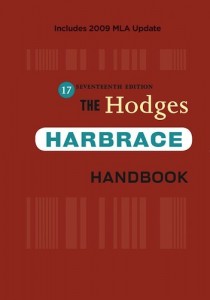

Book Summary
This handbook was one of the required materials for the online creative writing course I took through UC Berkeley. I currently own the 17th edition, published in 2009 with an MLA update, though at the time of writing this review, an 18th edition has already been released (and you can be sure that more will follow).
Originally published in 1941 by English professor John Hodges as the Harbrace Handbook of English, this book has since evolved into one of the richest English writing resources available today. The contents are organized into seven parts:
- Grammar
- Mechanics
- Punctuation
- Spelling and Diction
- Effective Sentences
- Writing
- Research and Documentation
Parts are subdivided into chapters and color-coded for your convenience (sorry, I couldn’t resist). Also included are a preface by the authors outlining new features and revisions for the current edition, a glossary of usage, a glossary of frequently used terms, and an index.
Pros
The first thing one might notice upon opening The Hodges Harbrace Handbook is the table of contents printed right into the back of the front cover and the first pages. At a glance, it’s clear how thorough this manual is, covering as many topics as possible from grammar and mechanics to proper usage of English in college-level writing. The table provides a quick guide to different sections and chapters, which are colored and numbered for easy reference.
As for the actual content, I find the explanations easy to understand, bearing in mind that the book is geared toward college students and above. To add to the educational experience, practice exercises are included within chapters, as are checklists for certain cases that come up in the editing process. Other notable features are the special boxes interspersed throughout the book: “Thinking Rhetorically” invites writers to consider the impact of their writing choices on their target audience; “Multilingual Writers” notes common areas of confusion for English learners, especially those for whom English is not a first language; and “Tech Savvy” provides helpful tips for using word-processing software, a useful feature for writers of the digital age. The last pages of the handbook include indexes for “Multilingual Writers” boxes, checklists and revision symbols.
One of my favorite details about the most recent editions of The Hodges Harbrace Handbook is the update for writers of modern times. As of the 17th edition, a new chapter titled “Online Writing” is included in the “Writing” part of the guide, and revisions reflect updates to MLA and APA guidelines and an expansion to a chapter on using writing software for business. Because of these updates, I would strongly advise against purchasing any edition of this handbook earlier than the 17th, published in 2009.
Cons
Honestly, this list is pretty short. In fact, the first issue I found with this handbook may have been due to error on my part. There were a couple of questions for which I couldn’t find answers in the handbook, either because I was searching for them in the wrong chapters or because they simply weren’t there. Also, the preface mentions some supplemental materials that are only available when bundled with the handbook at an additional cost. Not exactly a downside, but just a point to keep in mind if you’re looking for a complete learning experience to go with this guide.
Oh, and of course there’s the matter of price. A new latest-edition hard copy goes for over $80 on Amazon, which may seem steep to a student who only plans on using it for a semester. On the other hand, a prolific writer who needs to constantly edit and revise their work would probably find any price under $100 quite reasonable. As with any product, it’s all a matter of whether or not you feel you’d be able to get your money’s worth out of it.
Summary
Pros
- Versatile and thorough guide to the English language
- Well-organized contents
- Easy to understand
- In-chapter practice exercises
- Special boxes for “Thinking Rhetorically”, “Multilingual Writers” and “Tech Savvy” tips
- Extra indexes for “Multilingual Writers”, checklists and revision symbols
- Updated edition for writing in the modern age
Cons
- Possible missing information
- Supplemental materials available at additional cost
- Price ($80+ new on Amazon)
Conclusion
I highly recommend this handbook to any writer who puts as much effort into editing as into writing, if not more. Though I purchased my copy as a requirement for a class two years ago, I have since found it quite helpful when revising my work, and continue to use it today. Whether you’re looking for a complete guide to basic grammar or a full learning experience in the English language, The Hodges Harbrace Handbook is a great resource to keep handy, as much for the student writing for college as for the creative individual writing for life.
by Naomi L. | September 4, 2013 | Blog, Creative Writing, Off The Bookshelf |
Since the 9th century, the legend of King Arthur has been a well-known and popular one, spawning several myths and original retellings around the world over hundreds of years. Today, modern adaptations of Arthurian legend are hardly in short supply, from fantasy fiction portraying tales of the Knights of the Round Table to historical nonfiction seeking the truth behind the myths. Among the Arthurian fantasy novels that stand out the most, however, is Marion Zimmer Bradley’s celebrated four-part saga: The Mists of Avalon.

The Mists of Avalon, by Marion Zimmer Bradley
Summary
The novel series was first released in the United States by publisher Alfred A. Knopf in January 1983, for a targeted audience of adults, particularly women of any mature age. The Mists of Avalon tells the story of the rise and fall of King Arthur Pendragon in Britain during the late 5th and early 6th centuries, spanning across generations to narrate events from a little before his birth to sometime after his death. While it still encompasses many of the legend’s fantasy elements so well known today, the saga has a creative twist in that it relates the entire Arthurian legend from a completely different perspective: that of the female characters.
Review
As excited as any admirer of medieval fantasy fiction may be to start on a novel series with an Arthurian theme, the sheer length of this saga may prove daunting enough to warrant it a place on a summer reading list instead. This would likely turn out to be a wise decision, for one quickly discovers that Bradley’s elaborate plot, complex characters, detailed descriptions of medieval Britain, and fantastically original perspective of the Arthurian legend are capable of making the novels nearly impossible to put down for periods longer than are enough for basic necessary tasks, such as eating and sleeping. It’s arguable that enraptured readers would probably reach the end of the book well before the aforementioned list’s respective summer is over, and somehow feeling more conscious of – and respectful toward – the many possible interpretations of the story of King Arthur.
One of the most obvious themes that sets this novel apart from other Arthurian adaptations is feminism. The most widely known versions of these myths portray King Arthur and the Knights of the Round Table as the heroes of the story, while the women remain further toward the background as supporting characters with only a few key roles. In The Mists of Avalon, it’s almost exactly the opposite; Arthur and the other male characters sink into supporting roles, while the women rise up to become the protagonists in this original retelling. Readers are brought into the same world they know so well from the classic tales of King Arthur, yet at the same time, it becomes an entirely different world altogether, proving that vantage point really does make all the difference in the telling of a story.
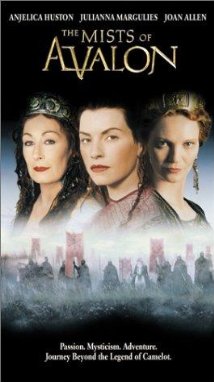
The Mists of Avalon (2001 TV Movie)
The majority of the narrative is told from the perspective of Arthur’s half-sister: the Avalon priestess Morgaine (known as Morgan le Fay in other Arthurian tales). Many chapters are also narrated from the viewpoints of other important women, among them Arthur’s wife, Queen Gwenhwyfar (the Welsh spelling of ‘Guinevere’); Avalon High Priestess and Lady of the Lake, Viviane; and Arthur and Morgaine’s mother, Igraine. Not only are these characters graced with much longer periods in the center of the narration, but Bradley also does a wonderful job of pulling these women out of their original unidimensional roles and giving them true depth, making them worthy of protagonism. Morgaine is no longer just an evil witch or a simple healer, but a strong druid priestess with good intentions and a tragic destiny. In turn, Gwenhwyfar’s innocent Christian veil is not just a plain matter of faith, but a slow descent into fanaticism brought on by an inferiority complex, her inability to bear children, and her search for salvation from her not-so-innocent infatuation with her husband’s best knight.
Which leads into the next main theme of the book: religion. One of the basic historical aspects of the Arthurian legend is the Christianization of Anglo-Saxon England, at a time when paganism was equally common. Again, a new light is shed on the story, as the conquering over dark pagan ways by Christianity becomes more of a struggle of rising tension and intolerance of the increasingly unstable balance between religions. The matriarchal society of Avalon is cast onto the defensive side against the overbearing patriarchal Church, eventually leading into a sequence of events in which Morgaine and the pagans strive to save Avalon and their native religion from disappearing from their country’s history altogether. Obviously, such strong religious implications – as is true of many novels with similar themes, notably Dan Brown’s The Da Vinci Code and Philip Pullman’s His Dark Materials trilogy – tend to spark equally strong criticism from religious groups, likely qualifying this book for a more “tolerant” audience.
Many might argue that it takes a certain kind of reader to enjoy a story like this, which boasts a generous share of heavy mature themes, such as sexuality and political radicalism. In light of such arguments, it may be best to recommend the series to readers deemed mature enough to refrain from dwelling excessively on these superficial themes (key as they are in many parts of the narrative) and truly appreciate the central concept Ms. Bradley intended to portray in her books: a story isn’t necessarily a simple matter of black and white or good and evil, but instead may hold several truths.
Inspiration
I first read this series when I was 14, after my mother gave me the single four-part volume as a Christmas gift. Since immersing myself in the world of Avalon, this saga has inspired me for its unique take on the legend of King Arthur, a story that has always fascinated me for its fantasy themes and insights into Celtic mythology. It was interesting to read this classic tale from the perspective of the women, and I quickly became entranced by the core theme of feminism present throughout The Mists of Avalon. Looking back, I’m glad my mom considered me mature enough to read the novels during my adolescence, for they introduced me to major political and religious topics during a key stage in my development as an independent thinker, and have thus become a great inspiration for the subtexts and themes that I like to write into some of my own stories.
The Mists of Avalon is, in my opinion, a classic work of art. Whether you’re an Arthurian enthusiast, a feminist, an intellectual with a fascination for religious debate, or simply a fan of well-written fantasy fiction, you will most likely enjoy this book. And if you happen to fit into every one of the above categories – as this writer likes to think she does – you will certainly devour it in no time, and still be left hungry for more.
by Naomi L. | August 7, 2013 | Blog, Creative Writing, Off The Bookshelf |
OK, it’s time to share another inspiring selection from my bookshelf. Because last week’s Notable Authors post was dedicated to J.K. Rowling, today’s Off The Bookshelf topic is a complementary review of her most famous works. Since I couldn’t say that only one of these books has inspired me, instead I’d like to briefly cover some general points of all seven of the author’s world-famous fantasy novels: the Harry Potter series.
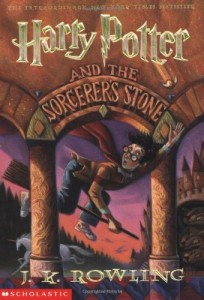
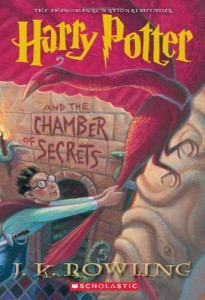

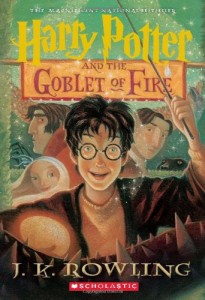
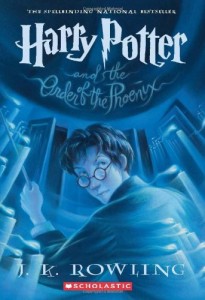
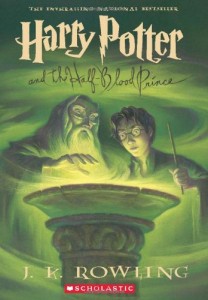
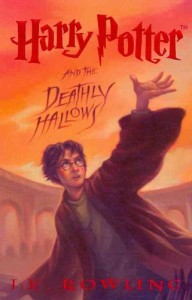
Summary
First published in the United Kingdom by Bloomsbury (June 1997) and in the United States by Scholastic (September 1998), the Harry Potter series consists of seven novels primarily in the fantasy genre, written for a target audience of young readers from children to young adults. The books tell the coming-of-age story of Harry Potter, a wizard boy who gained fame in the underground wizarding world as a baby after mysteriously surviving an encounter with the Dark sorcerer who terrorized the magical community and killed his parents. The series focuses mainly on Harry’s adventures with his friends Ron Weasley and Hermione Granger at Hogwarts School of Witchcraft and Wizardry between the ages of 11 and 17, with each book taking place over one year of the characters’ lives, all strung together through a story arc about the young protagonist’s quest to unravel the mysteries of his life and ultimately destroy the power-hungry Lord Voldemort to save the magical and nonmagical worlds from his evil reign once and for all.
Review
The Harry Potter books have gained incredible success since the first publication of Harry Potter and the Sorcerer’s Stone (if you’ll forgive my use of the American title, since it’s the one with which I’m most familiar), and with such high popularity and critical acclaim, it’s easy to see why. Rowling’s intricate world, compelling characters and engaging storyline quickly drew in millions of readers worldwide, and boosted the novels to become the best-selling book series in history by mid-2011.
Although it’s mostly considered fantasy for its predominant theme of magic, Harry Potter also falls under such genres as mystery, thriller and coming of age. This makes it a very versatile and unique read, which may partly explain its enormous success. Despite appearing as a children’s story about wizards on the surface, the series has many levels to it that make it appealing to a broader range of readers. For instance, those who don’t care so much for fantasy might still enjoy Harry Potter as an adventure story at its core, or for its mystery elements, or even as a tale about a young boy trying to find out who he really is. Aside from its overlapping genres, the author also made a point of allowing various themes to blossom throughout her work, including the trials of adolescence, political subtexts, and especially death.
One of the most notable achievements of this series was the fact that it encouraged so many children to read. Yet there was more to it than just getting kids to pick up books they would normally consider above their reading level. As one of the children of the Potter generation, I can attest to the special experience of growing up with the main characters. I read the first book when I was very close to 11 years old and finished the last one not long after turning 17, and because of the way the series gradually progressed into darker themes with each new book, Harry Potter was the key work of literature in my transition from lighter children’s stories to more mature fiction, helping me to develop both as a reader and as a writer.
There’s no question that these books will forever be revered throughout the history of literature, not only for their record-breaking commercial success, but for their tremendous cultural impact. The series has inspired an entire generation of young readers, and it will always hold a special place in the hearts of the millions who have been touched by the magic of Harry Potter.
Inspiration
If Roald Dahl first hooked me on fantasy stories with Charlie and the Chocolate Factory, J.K. Rowling kept me forever loyal to the genre with Harry Potter. As I like to put it, “I came for the chocolate factory, and stayed for the wizarding school.”
Harry Potter has been a huge inspiration to me since my childhood, as much in fantasy specifically as in the rest of my writing in general. The books have opened my eyes to a wonderful world of fiction, and they’ve taught me a great deal about the techniques and passion it takes to create a magical universe. I’ve been an aspiring fantasy author since I fell in love with creative writing as a child, and I can honestly say that this series has played a major part in keeping my dream alive for so many years. No matter how many other novels I go on to read and even write throughout my life, the Harry Potter books are and always will be among my absolute favorites.
by Naomi L. | June 5, 2013 | Blog, Creative Writing, Off The Bookshelf |
So I wanted to start a section of my blog focusing on sources of inspiration, that is, what inspires me as a writer and what I hope can inspire others as artists. The first idea that came to mind was a subtopic for the books I’ve read that have motivated me in my writing, sort of like a virtual bookshelf. Then I thought, what better book to start off with than the one that first inspired me to become a writer? So here is a brief review of one of my favorite books as a child: Charlie and the Chocolate Factory by Roald Dahl.
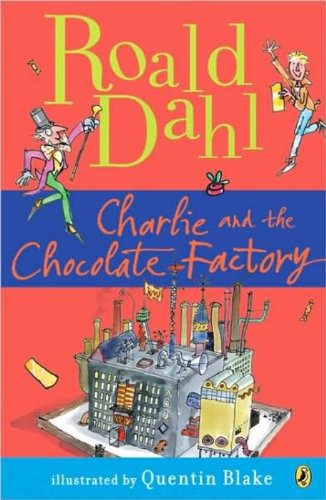
Charlie and the Chocolate Factory, by Roald Dahl
Summary
In case you haven’t yet read the book (first published in 1964) or seen either of the movie adaptations (released in 1971 and 2005), Charlie and the Chocolate Factory tells the story of Charlie Bucket, a kind and honest young boy of very humble origins who has always been intrigued by the mysterious chocolate factory located near his home, run by the legendary Willy Wonka. One day, Charlie’s wildest dreams come true when he becomes one of only five lucky children around the world to find a golden ticket inside a Wonka’s chocolate bar, constituting an invitation from the famous chocolatier himself to visit his factory for an entire day. Fantastical adventures ensue as Charlie and the others follow Mr. Wonka on a magical tour through the strange facility, at the end of which lies a special grand prize for only one very lucky child. How will things fare for our hero and the four terrible brats as they discover the wonders of Wonka’s chocolate factory? It’s the greatest adventure of young Charlie’s life, and he can’t wait to find out!
Review
I first read this book when I was nine years old, at the recommendation of my mother. Though I was no stranger to reading, it was the first book I ever read that was written by Roald Dahl, and consequently, it became the reason he was my favorite author growing up. Charlie and the Chocolate Factory fulfilled a great wish I had throughout my entire childhood: to escape into a magical world far from the realm of reality.
As I read the story, I lived vicariously through the character of Charlie Bucket, who had the amazing opportunity to step out of his ordinary life and spend a day in a land of fantasy. Today, I look at him as an excellent role model for young children: humble, honest and with a vivid imagination. Willy Wonka is a wonderfully eccentric character, likely intended as a personification of the dreamer mentality lost on many of the “normal” adults in the author’s stories; and the four children joining Charlie on his adventure have such ridiculously bratty personalities that it can only make for some hilarious scenarios during the course of the factory tour.
But it wasn’t just the story that I loved; it was the way it was told. Mr. Dahl always had a very creative style of narrating his children’s books that appealed as much to his young target audience as to the metaphorical child in each of his older readers, and Charlie and the Chocolate Factory is no exception. Every time one of the bratty golden ticket winners gets into trouble, the situation is resolved in a unique and comical way as could only come from a mind as imaginative as Dahl’s. The songs sung by the factory’s Oompa Loompa workers are not only funny, but actually teach valuable lessons, though it’s safe to assume the advantages of reading over watching television and the prominent role that parents play in raising spoiled children are already common knowledge. Even the various candies and chocolate delights described throughout the story sound so delicious and inventive, you wish you could reach into the pages and try some for yourself (except maybe the chewing gum).
Inspiration
Though I was already a longtime fan of fiction, this was the first book to make me want to write stories of my own. The joy I felt when escaping into Charlie’s world inspired me to follow Mr. Dahl’s lead and create magical adventures for others to enjoy, and for that, I will always admire him as one of my all-time favorite authors. With its wild twists, eccentric characters and endless supply of phizz-whizzing fun, Charlie and the Chocolate Factory is a great read for the imaginative child in any reader, and especially for the dreamer in every fiction writer. One could expect nothing less from the world’s most scrumdiddlyumptious storyteller!
by Naomi L. | May 1, 2013 | Blog, Creative Writing, Featured, Writer's Toolkit |
Every writer who is serious about their craft needs to have a well-stocked writing toolkit at their disposal. Of course, the exact tools may vary among the different artists who choose to use them: a poet may use only small notebooks for jotting down his thoughts, while a short story writer may also choose to keep index cards for organizing her ideas, while a novelist may have a whole bulletin board (or even a room full of them) for keeping track of elaborate plots. Some tools can be seen as universal necessities to all creative writers (such as journals and the aforementioned notebooks), and others seem to be more of a personal preference (such as index cards and exercise books).
In the interest of exploring this array of choices, I’ll be telling about my experience with the instruments in my own writer’s toolkit, starting with a fantastic book of fiction exercises that has proven to be a valuable asset to me: What If? Writing Exercises for Fiction Writers, by Anne Bernays and Pamela Painter.
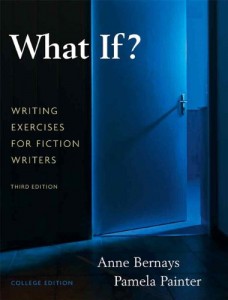
What If? Writing Exercises for Fiction Writers, by Anne Bernays and Pamela Painter
About the Book
I bought this book for the online creative writing class I took through UC Berkeley back in 2011. The copy I own is the third edition, also called the college edition, which was released in 2009. It holds 109 exercises covering 13 different topics, plus 11 short short stories and 14 short stories provided at the end of the book. Also included with every exercise description is an explanation of the objective behind it, as well as the occasional example courtesy of the authors’ students.
The topics (or parts) covered in the book are:
- Beginnings;
- Characterization;
- Point of View, Perspective, Distance;
- Dialogue;
- The Interior Landscape of Your Characters;
- Plot;
- The Elements of Style;
- A Writer’s Toolbox;
- Invention and a Bit of Inspiration;
- Revision: Rewriting is Writing;
- Sudden, Flash, Micro, Nano: Writing the Short Short Story;
- Learning from the Greats; and
- Notebooks, Journals, and Memory.
So what can I tell you about the book? Here are a few key points I’ve learned from my experience.
Pros
The diversity of topics in the book allows you to “custom improve” your writing in the areas you feel need the most work. The explanations are easy to understand, and the student examples are excellent models of the techniques taught through the exercises. For a truly well-rounded experience, a friendly introduction by Bernays and Painter encourages all readers to explore the potential of their writer’s voice and explains the separate definitions of writing like a writer and thinking like one, while the last two sections provide 25 excellent stories to better illustrate the points made throughout the book. Needless to say (oops, Exercise 51: “Word Packages are Not Gifts”),What If? covers a wide enough spread to make it an excellent resource for any fiction writer, as much for the beginner in need of good practice as for the seasoned writer looking to rekindle the fire of inspiration.
But nothing is perfect, right? Now for the downsides…
Cons
The main obvious drawback about using What If? is that it practically requires sharing of completed exercises and subsequent receiving of critique in order for its readers to get the full intended benefits of the book, making it a more popular choice for creative writing workshops and courses as opposed to individual study. Aside from this, readers might find a couple of topics to be lacking in sufficient exercises (Part Seven, for instance, only contains four), which might put off those hoping for a more diverse selection within a certain module. Also, not every written exercise comes with an example, leaving it solely up to the practicing writer to determine the intended approach to the exercise. This is fine for the more independent readers, but for those often looking for extra guidance (like me), it might prove to be a bit of a disappointment.
Still, I honestly don’t think these minor cons do much to outweigh the stronger pros. Yes, What If? is not without its flaws, but overall, I feel it’s a worthwhile read that warrants a place on any writer’s bookshelf.
Summary
Pros
- Wide diversity of topics (13 total)
- Exercise descriptions that are easy to understand
- Excellent student examples
- Friendly and comprehensive introduction
- 25 short stories
Cons
- Requires feedback for full experience
- Limited selection of exercises in some topics
- Lack of examples in some exercises
Conclusion
Why have I chosen to open my Writer’s Toolkit posts with this book? It wasn’t a matter of random choice, but rather one of relevance to my own writing. Many of the pieces I’ve written (and others which I’m currently writing) blossomed from the exercises contained in this book, and because of the enlightenment and fun I’ve had with them so far, as well as my need for critique from other writers, I decided to make a habit of sharing some of my own examples of attempts to complete them.
So whenever a certain piece I share in the future has been inspired by a What If? exercise, I’ll be sure to provide a brief explanation of that exercise for easier reference. However, if you’re a writer and you don’t have this book, I highly recommend that if you have the time (and the funds), you grab yourself a copy of What If? as soon as you can! You won’t be disappointed.
There you have it: the top creative writing book on my shelf, and one of the most useful resources in my writer’s toolkit. I hope you’ll enjoy the pieces I produce from these exercises, and I also invite you as aspiring writers to try them out for yourselves. In fact, if you have writing blogs of your own, by all means, please share links to your own pieces in the comment sections. I would love to read them! In the meantime, please feel free to offer your feedback on my work; I look forward to receiving constructive opinions that would help me to further improve my writing.
Thanks for reading! Happy writing!












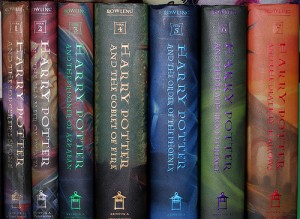



Recent Comments